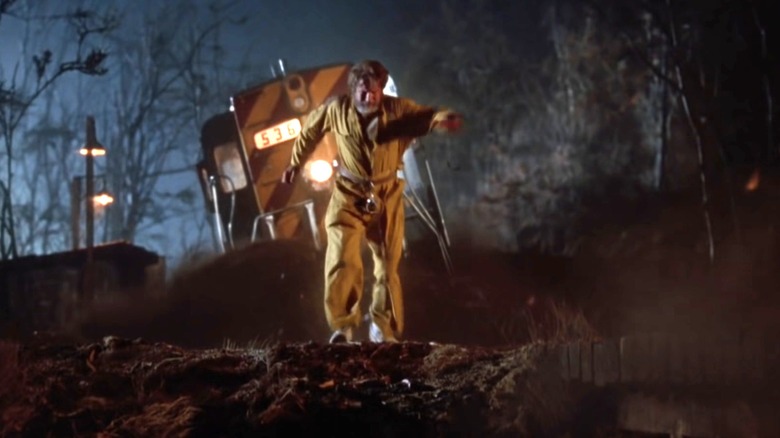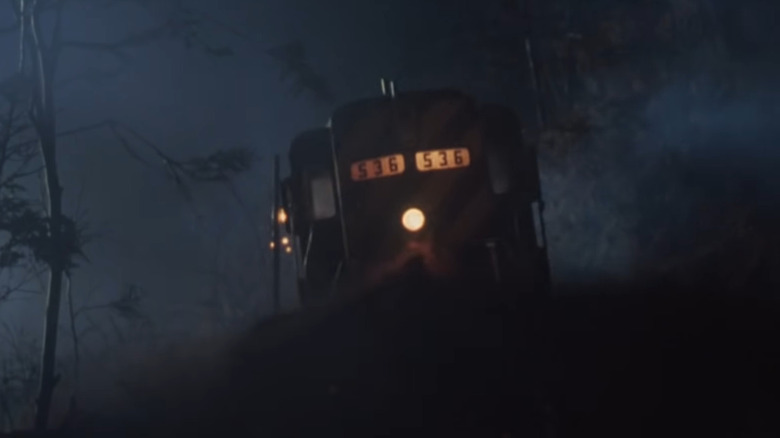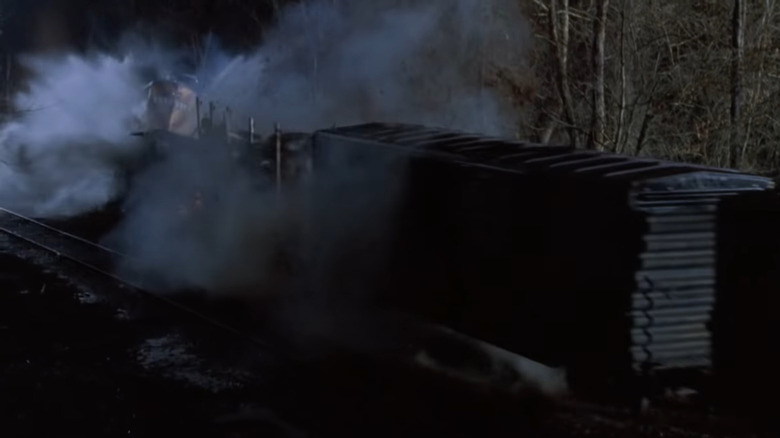The Fugitive Went All Out For That Fiery Train Wreck Scene
Sometimes, it's quite easy to explain why a film is great. "John Wick" is great because of the action sequences. "The Muppets Christmas Carol" is great because of the unexpected pairing of Muppets and Michael Caine. But for some movies, it's basically impossible to pin down a single reason they're great. "The Fugitive" is a great example of this.
There are countless reasons why "The Fugitive" rules. For starters, it has a perfect cast led by two charismatic stars: Harrison Ford and Tommy Lee Jones, both in their prime. The two are excellent, whether playing off each other or carrying a scene on their own. Those two could make a movie about two guys taking turns reading the manual to an air conditioning window unit and it would be amazing.
One of the film's numerous other strengths is its tight plotting. Every time Ford's fugitive doctor seems to get the upper hand, another problem emerges, forcing him to act quickly or be caught. Similarly, any time things seem to be going in Tommy Lee Jones' favor, Ford figures out some genius way to continue to evade him. It's a cat and mouse game where the stakes rise and fall, and the tension is masterfully maintained throughout.
But "The Fugitive" doesn't always get its proper due for its terrific set pieces. Whether it's Harrison Ford moving through a St. Patrick's Day parade or his famous jumping off a dam scene, "The Fugitive" knows how to spread these big moments throughout the movie and use them for maximum impact. Perhaps the biggest set piece is the train derailment near the beginning of the film. The scene is mesmerizing — literally a train wreck where you can't look away — and it's because the creators of the film went all-out making it realistic and exciting.
The good kind of train wreck
"The Fugitive" centers around Harrison Ford's Dr. Richard Kimble, a prominent Chicago doctor who arrives home one night to find his wife being brutally murdered. After a brief struggle with the assailant and a panicked 9-1-1 call, Kimble is wrongfully arrested for his wife's murder. He's set to face the death penalty — but while he's being transported on a bus full of inmates, there's an escape attempt. The driver is killed, the bus crashes and lands on nearby train tracks, and Kimble makes a daring escape in the nick of time as a train smashes into the bus.
The scene is very impressive, with explosions and train cars rolling around. According to director Andrew Davis, people often ask whether the train cars were real or models. According to a Los Angeles Times piece, the producers of the film used real train cars they had to buy in North Carolina, because they had asked every railroad company in five states and none wanted to have their trains involved in a crash — even a fictitious one.
The crew then built a spur off the tracks in order to create the illusion that the train was derailing, when in fact it was now simply on a different rail in another direction. With cameras set up in 16 locations, Davis and his team let the locomotive loose down the track, creating the impressive derailment we see in the final cut (this scene alone cost $1.5 million).
The remains remain
At the time, The Los Angeles Times called this scene "the new zenith in action movie excitement." The damage caused by the train wreck was very real; one of the cameras reportedly took eight hours to be unearthed after the crash, having been buried in 26 feet of dirt.
To Andrew Davis, it's no wonder that people love the scene. "People are cheering both because they got to go on this ride and because Ford escapes at the last moment," he said. "The scope and scale must impress them."
Indeed it did, and "The Fugitive" has certainly left its mark on movie history. It spawned a sequel for Tommy Lee Jones' United States Marshal character, aptly titled "U.S. Marshals," and it also earned the true mark of cultural relevance: a "Simpsons" parody in which Milhouse recreates Harrison Ford's deadly jump from a dam.
But the film also left some more literal marks, too. The remains of the train crash can still be found along the Great Smoky Railroad, rusting but with the fictional railroad name "Illinois Southern" still emblazoned on the side.
The authenticity and effort put into a train crash scene rather than simply crafting the scene entirely with models is one of the many, many reasons "The Fugitive" is great. It's a movie where truly every aspect hits on all cylinders, and the iconic train wreck is just one of the technical marvels that propels the film into legendary territory.


